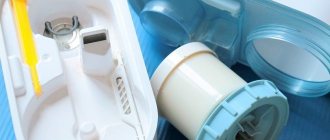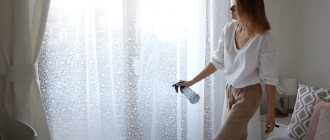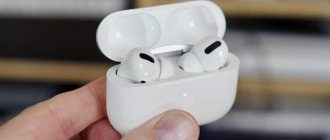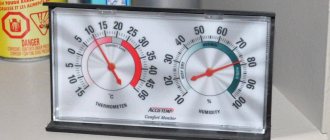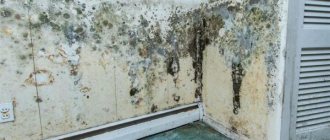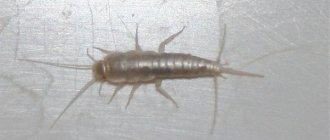What is air humidity
The air contains water vapor. Whether it is dry or wet depends on its quantity. Air humidity is measured as a percentage.
The weather forecast always indicates air humidity. It depends on how a person feels on the street. When it’s hot and raining, the humidity is almost 100%, so you get a feeling of stuffiness. With strong wind and humidity less than 30%, there is a feeling of dryness in the mouth, throat, and nose.
Air types and humidity:
- very humid air - above 85%;
- moderately humid air - 70-85%;
- moderately dry air - 55-70%;
- dry air - 30-55%;
- very dry air - below 30%.
In the Sahara Desert, air humidity is 20-30%
Humidity imbalance and what causes it
There are several factors that affect the humidity in an apartment:
- Ventilation. It’s not for nothing that a high-quality ventilation device costs a lot of money. If air circulation does not occur and there is no constant outflow of humidity, all this accumulates indoors, creating a greenhouse effect.
- Temperature. You also need to take into account that the higher the air temperature, the higher its ability to absorb moisture. That's why it's so suffocatingly humid in the tropics and scorching hot in the desert. For an apartment, it is necessary to find that pleasant balance between the “tropics” and the “desert,” somewhere in the “birch forest on the bank of a river.”
- Operation of heating devices. Artificial heating of the air leads to the removal of moisture from it, which leads to overdrying. Which, in turn, affects the mucous membrane, making it vulnerable to viral diseases. Therefore, doctors recommend using humidifiers during the heating season. But we'll talk about this in more detail below.
- Congestion of houses. Today, when building houses, it has become very “fashionable” to worry that it should be built only from “breathable” materials. After all, if moisture is not removed naturally, then not only does the humidity in the house increase, but mold also grows, and the air becomes musty. Therefore, they try to arrange facades with ventilation gaps, purchase only “breathable” plaster and wallpaper, and opt for high-quality insulation materials that allow air to pass through well, for example, basalt, mineral wool.
- Air pollution. This is another reason for humidity destabilization. At the same time, it is not necessary to keep a clandestine laboratory in your home to “pollute” the air. It is enough to stay at home and do your normal business. The problem can be solved simply by good ventilation of all rooms.
In principle, a gas mask is a good way to hide from unfavorable “weather in the house.”
So, let’s summarize. In order for the humidity to be normal, you need to build a house only from “breathable” materials, arrange good ventilation, monitor the temperature and ventilate the room more often. If the latter costs us nothing, then many “get along” with the previous factors in their “non-ideal” homes. Let's take a closer look at what to do in such cases.
Optimal air humidity in an apartment according to GOST
Normal air humidity is so important for human health, productive work and comfortable living that for a long time at the state level they have been determining its optimal norm for various premises. She is especially monitored in preschool institutions. GOST 30494-96 is just such an official document that regulates the standards for such an indicator.
This document discusses concepts such as optimal and permissible air humidity values. The first designates a set of characteristics in which a person feels comfortable for a long time. Acceptable values are, so to speak, a “compromise”, it seems that it is not what we would like, but it will be accepted for lack of a better one. With such parameters, a violation of the general state of health is observed.
Attention! All measurements were made with the condition that humidity standards were favorable for 80% of the inhabitants of the room. But you can’t please everyone, some people like the heat, but for others, dry air is a dream. Therefore, below we will rely on the values of GOST standards.
Norm for apartments in winter
Physiologists have calculated that the optimal air humidity in an apartment all year round is in the range of 30 to 40 percent. However, from autumn to spring, people use radiator heating and additional heating devices that can dry out the air, which is extremely undesirable. Changes in temperature outside also make adjustments.
The indicators are affected by:
- Availability and quality of insulation in the floor and interfloor ceilings.
- The type of material from which external walls and interior partitions are built.
- The amount of glazing, doorways, frequency of door openings, quality of double-glazed windows.
If in the case of autonomous heating it is possible to set the temperature and maintain it constantly, when using a centralized heating system there is no such possibility. Each jump leads to a change in humidity, and measures must be taken immediately to stabilize the situation.
In winter, the parameter should not go beyond 60%, but it also cannot fall below 40%, according to physiologists. But this is provided that the indoor temperature is +18...+24°C, which is also a requirement of the aforementioned GOST number 30494-96.
Humidity norm for a child
In this case, it is necessary to especially carefully ensure that the humidity in the apartment never goes beyond the norm. Children are more susceptible to overheating and hypothermia than adults.
Excess moisture leads to the appearance of colonies of harmful parasites: fungus, mold, microorganisms, bacteria, viruses. And while the immune system is too weak, the child gets sick. And even if this is a teenager, fatigue, inability to concentrate, general malaise and weakness lead to a decrease in school performance.
The opposite situation is when, in the fight against dampness, parents reduce the humidity below the minimum limit, the skin and mucous membrane of the baby’s eyes dry out. Dehydration is a cause of deterioration of the immune system, and even if the mouth is simply dry and the lips are cracked, there is a threat of exposing the baby to bacteria, leaving him without the means to fight infections.
And safe air humidity in the room where a child sleeps, eats and plays is considered to be 50-60% at +24°C. In case of illness, it is recommended to increase it to 70%.
Comfortable indoor humidity for humans
It is immediately necessary to make a reservation that for each room, depending on the intended purpose, its own parameters are set. A properly created microclimate is a guarantee of good health, high performance, and sound sleep. But people are often carried away by trying to maintain a comfortable temperature, forgetting that the normal air humidity in the apartment should be within the limits recommended by doctors. Indeed, even the perception of temperature depends on this parameter.
It is the excess dampness that leads to the formation of condensation on the glass and pipes of cold water risers. Water molecules simply concentrate on the surface of cold objects and precipitate in the form of droplets visible to the naked eye. If we consider the optimal indicators for rooms, then the humidity level and temperature should be within the following limits:
- For the bedroom it is 16-20 degrees. S. and 40-55 percent.
- In the kitchen 19-22 °C, 40-50%.
- In the workroom 18-22°C at 30-40%.
- Children's, playroom - from 18 to 24° C, from 50 to 60%.
- In the shower or bathroom 21-23 degrees at 40-55 percent.
- For the hallway, hall 18-19 degrees, 40-45%.
- Living room, guest room, hall, dining room - 18-23 and 40-50, respectively.
- In the toilet, bathroom 16-19 degrees. at 40-45%.
We recommend: Why do you need a bypass in a heating system, installing a bypass line
Those who maintain a greenhouse must ensure that the plants are comfortable in it. To do this, you will have to maintain the temperature within 16-25°C, while the humidity level is 50-70%, which depends on the types of crops grown. From the above it can be seen that in the greenhouse, kitchen and bathroom the indicator is higher. Adhering to the minimum limit is also important, because if the air is dry, there are a lot of suspended dust particles in the air, which are harmful to the lungs.
Going beyond the norm leads to other consequences, since excess moisture is also a negative factor. For plant growth, the range is limited to 50-75%. Where people spend a lot of time, this figure should not go beyond 40-70%.
For the normal operation of household appliances and electrical appliances and their safe use, limits of 40-60% are set. In this range, books, furniture, draperies and decorative items do not deteriorate.
Otherwise, their service life is sharply reduced, which leads to unexpected expenses.
How to measure: 4 ways
How to find out the air humidity in the house and increase it, if necessary - there are four proven methods for this. The most reliable way to use a hygrometer is a reliable device for measuring indoor air humidity. How do you measure air humidity in an apartment when there is no hygrometer? With improvised means. Of course, they will not provide exact digital data, but in general they will determine whether the air in the home needs drying or additional humidification.
- Hygrometer. This device is easy to use and will quickly display accurate and absolute temperature and moisture percentage in the atmosphere. There are several types of devices: psychrometric, electronic, mechanical, condensation, hair and weight. The most convenient and accurate, according to users, is an electronic device that can be installed permanently or moved as needed from one room to another.
- Assmann's psychrometric table. Record the temperature readings on a room thermometer. Wrap the head of the device with mercury with a wet cloth or cotton swab. After five to ten minutes, write down the result. Subtract the second number from the first temperature number. Then look at the Assmann table (see table below). In the vertical left column, find the first thermometer reading, in the horizontal top line - the second calculation. At the intersection of the numbers you will see the approximate moisture level in your room.
- Glass of water. Place a glass of water in the refrigerator for two to three hours, cooling the liquid to 3-5°C. At room temperature, observe the reaction of the water on the outer wall of the vessel for a few minutes. If within five to ten minutes the glass walls have managed to fog up and dry out, this indicates dry air. The glass continues to be fogged up - the humidity in the room is average; if condensation flows down in large drops, this is an indicator of too high humidity.
- Fir cone. Leave the spruce cone for several hours in a room away from heat sources. In a dry atmosphere, the scales will open, and with an increased degree of moisture, they will shrink tightly.
What happens from dry air.
When the cold season sets in and the heating is turned on in the apartments, the air begins to dry out. Due to lack of moisture, the body loses resistance. Dry mucous membranes no longer prevent viruses and bacteria, become thinner and allow them to pass through. Static electricity spreads germs and dust mites, causing allergies. The appearance also suffers from dry hair and skin.
Effects of dry air:
- Dried and lifeless hair, dry and thin skin. The result is split ends, wrinkles and cracks in the skin. Dermatitis worsens and resistance to infections is lost.
- Feeling of dry eyes, irritation. Feeling of the presence of sand or a foreign object. The strain on the eyes increases and due to fatigue, dry eye syndrome occurs.
- Slowing down digestion. This occurs from an increase in the viscosity of intestinal and gastric juices.
- In an environment with dry air, respiratory allergens actively multiply. This is contraindicated for people with allergies, and especially asthma.
- Dizziness, headaches, general weakness and increased stress on the heart. These are consequences of blood thickening and slowing of its circulation.
- Dried mucous membranes begin to let more viruses through, and people suffer from respiratory infections more often. The thinning of the protective membrane causes nosebleeds.
Important to know Indoor plants and pets suffer from lack of sufficient air humidification. The wear life of natural wood furniture is reduced.
Consequences of air with excess moisture
Significantly exceeding the norm of humidity in an apartment also has a large number of negative consequences. The maximum values for a living room in the summer are 65%, and during the heating period 60%. If the conditions are not met, then harmful bacteria and mold fungus appear in the apartment.
What happens when humidity levels are too high?
- Respiratory tract diseases are becoming common, which do not cure for a long time and can cause complications. Chronic diseases such as asthma are acquired. For those who already have this disease, excessively humid air threatens frequent exacerbations.
- Dampness is felt and causes unpleasant odors. The presence of stuffiness is getting worse. There is a loss of feeling of freshness in the apartment.
- Washed laundry takes longer to dry.
Excess moisture is especially harmful for people with allergies; pathogenic organisms and mold fungus have a bad effect on their health. Humidity is also harmful to plants, as it causes them to rot. Furniture and things also suffer. Wood products become deformed and cracks appear. Things in the closet acquire an unpleasant odor and turn yellow.
If there is constant condensation on the windows in the apartment, it means that the humidity in it is increased.
Methods for determining air humidity in an apartment
Humidity is measured with a hygrometer. There are mechanical and electronic models.
The indoor mechanical device is inexpensive and easy to operate.
Electronic hygrometer
There are measurement errors, but high accuracy is not required for home use. The main condition: there should be no sudden changes in humidity in the room. In addition, the arrow moves slowly, and the data is displayed with a noticeable delay.
Electronic hygrometers have more accurate results, but they are also more expensive. Compared to mechanical ones, they show the current humidity with a slight delay of 5 to 60 seconds.
When choosing, you should pay attention to the required measurement ranges. So, a household hair or condensation hygrometer is quite suitable for rooms, but in a sauna it will not be able to show the actual relative humidity.
Modern hygrometers are often produced in combination with thermocouples, clocks, thermometers, barometers and even baby monitors. In addition, the arsenal of electronic models includes various functions of sound notification, light display and alarm, and data storage.
There are several ways to determine humidity without a hygrometer.
- Cool a glass of water to 3-5⁰ C. Place it in the middle of the room and watch for condensation. The air is too dry if the steam on the walls dries out in the first 10 minutes. If moisture collects in drops or flows down the walls, the humidity is increased. The walls are fogged up, but they do not form drops, and the condensation does not evaporate instantly - all this indicates that the air humidity in the apartment is normal.
- You can tell about the imbalance by looking at regular salt. If the salt is heavy and wet, the air is oversaturated with vapor. If it is compacted into a dense lump, the climate is too dry.
- It is necessary to record the current data of the thermometer, and then wrap it with a damp cloth. After a few minutes, take readings. Determine the difference between the first and second results. Using the information obtained and Asman's table, you can find out the relative humidity in the room.
- The spruce cone opens at low humidity. When increased, it presses the scales tightly.
Table: measurement of microclimate parameters
| Parameter | Method | Peculiarities |
| Temperature | Thermometer | You cannot measure the temperature with a thermometer on a clear day with the curtains open - sunlight will knock down the readings, increasing them by 1-3 degrees. To get the most accurate indicator, you need to measure three times with five-minute breaks and calculate the arithmetic average. |
| Humidity | Hygrometer | A hygrometer is a special device that is installed in a room and, like a thermometer, indicates the current humidity value on the display. Hygrometers can be either digital or analog. You need to choose a device with an error of no more than 1%. |
| Psychrometer | A special type of hygrometer is a psychrometer, which consists of two mercury thermometers with a reservoir of water connected to one of them. Install the device in the room of interest and measure the temperature. You need to calculate the difference in the readings of the two thermometers and compare it with the table that comes with the psychrometer - it shows the humidity indicator. | |
| Wet glass | Fill a glass beaker with cold water and place it in the refrigerator for several hours to cool it down to 3–5°C. Place a glass of chilled water in the room (away from the heating) and keep an eye on it. The outside of the glass will become covered with drops and fog up. If it dries out after 5–10 minutes, the air is very dry and additional humidification is necessary. If drops flow, the air is too humid. If the condensation remains and does not flow within 10 minutes, then the air has optimal humidity. | |
| Thermometer | This method can simulate the effect of a psychrometer. Measure the room temperature and record the reading. After this, wrap the thermometer in damp gauze and measure the temperature in the same room again. Calculate the difference in the indicators and check the psychrometric table (it is easy to find on the Internet). | |
| Candle | Close the windows and doors and light a candle. If it burns evenly and brightly, then the humidity is optimal. But an uneven, jumping flame with bright spots around the edges indicates too high a moisture content. |
If the humidity in the house is low
If the humidity is below normal, the air is dry. This is fraught with a number of problems and troubles for our bodies. For example, such as drying of the mucous membrane of the eyes, dry throat, and dry skin. Dry air often causes a sore throat and cough. Static electricity problems may occur in your home, and furniture and other wood elements may dry out and crack.
Let's note the fact that children need more humid air.
How to increase air humidity in an apartment
- Use special devices - humidifiers...
- Natural evaporation of water - place a vessel with water in close proximity to the heating device (if it is winter). The water will evaporate, and the water vapor will humidify the air.
- You can dry washed clothes, linens indoors...
- Get or increase the number of indoor plants.
Determining air humidity without a device
There are traditional ways to determine the humidity in a room. To try them out, take a glass of water and a fir cone.
You need to pour water into a glass and place it in the refrigerator. After it has stood there for 3 hours, remove it and place it away from the heat source. Then leave the glass alone for 5 minutes. As time passes, you need to observe what happens to him. Condensation should form on the walls of the glass.
If the walls are dry within a few minutes, then the room is dry. Condensation remains unchanged - this means an optimal level of humidification. Flowing streams of water indicate high humidity.
We recommend: Insulating a well for the winter with your own hands: methods, depth of soil freezing, video and photos
Another way to determine is using a fir cone. A lump is taken and placed in the room being tested, away from radiators and heat sources. Leave for a couple of hours, then examine the scales. In case of dryness, they open; in case of excessive moisture, on the contrary, they shrink.
To check the air for dryness, you need to pay attention to the bed linen after washing. If it dries no longer than 1.5 hours, then the apartment requires humidification.
These methods provide indicators that you need to roughly focus on. To measure and obtain accurate readings, you must purchase a sensor that detects humidity.
Interesting If the tips of indoor plants are yellowed and dry, then the climate in the apartment is too dry. And clothes made of synthetic materials will begin to become highly electrified.
How to determine the humidity level?
Let's look at 2 ways to determine the level.
The first method recommended to everyone is to use the device . A hygrometer is used for measurement. A simple indoor model costs about 350-500 rubles.
Home weather station: clock + thermometer + hygrometer
It comes in several types (according to the principle of operation), different sizes and shapes, with additional functionality (for apartments, a hygrometer with a thermometer is best suited). It can be hung in the bedroom, bathroom and kitchen. Constant monitoring is especially useful in a nursery or in a room where a person with serious illnesses lives.
The second way is with a glass of water . Since hygrometers are cheap and determine the exact percentage, this method is best used as a last resort.
To check: take a glass of water at room temperature, put it in the refrigerator for 3 hours, and place it on the table away from any heat sources (battery, heater, computer system unit). Within a few minutes, condensation—drops of moisture—will appear on the glass.
To determine humidity, we look at how the condensate “behaves”:
- dry - low humidity;
- drains quickly, a puddle collects under the glass - the humidity is high;
- drops remain on the walls, drain slowly - the humidity is normal, within normal limits.
Ways to normalize the microclimate
Once it has been possible to find out how much moisture is in the air at the moment, the question arises of how to increase or decrease its content to the desired level.
A humidifier will help make the air less dry. There are many models on the market at different prices.
You can increase the relative humidity without using special equipment. One option is to install a container of water next to the heater or radiator. An aquarium or fountain works in the same way as water basins, but looks more aesthetically pleasing and will last longer.
Open doors to the bathroom will help a lot. The water vapor remaining after taking a shower penetrates the room and humidifies the air.
You can dry your clothes in the apartment or cover the radiators with wet towels. Strips of fabric, one end dipped into a basin of water, also give a good effect. The other end of the material is placed on the battery.
A simple and effective way to increase humidity is to use a pan of boiling water. The only problem is that the room becomes warmer, and the air needs more moisture to saturate.
Regular wet cleaning not only helps remove large amounts of dust, but also allows the air to absorb the required amount of liquid.
Spathiphyllum, spiderweed, Boston fern, Areca catechu palm, aglaonema, rubber ficus, Dracaena marginata, bamboo palm - all these plants, with regular watering, actively release moisture during the day.
High humidity is contraindicated for people suffering from the following diseases:
- of cardio-vascular system;
- allergies;
- hypertension;
- atherosclerosis;
- pulmonary diseases.
Reduces relative humidity:
- Air conditioner. The circulation of air masses helps to cope with dampness in the house.
- Air Dryer. The air passes through a metal coil, condensing moisture into a special container. You can find a variety of models in stores. There are absorption dehumidifiers that use absorbent materials such as silica gel.
- Removing carpets, as they absorb moisture and do not dry well.
- Ventilation. A good way to reduce humidity during the heating season.
- Forced ventilation. It is necessary to check all hoods in the apartment. If they are not littered or obscured by objects, but still do not pull well, a breather would be the best solution.
- Troubleshooting. Dampness in an apartment is often caused by leaks. It is easier to eliminate the cause itself than to deal with the consequences.
- Bricks, salt and wood briquettes. A large bag of salt or blocks of charcoal simply needs to be laid out by opening the packaging. Bricks must be heated and placed on fireproof surfaces in the home.
Knowing what the optimal humidity should be in a room can improve living conditions.
Both various devices and folk remedies can measure air humidity and correct the situation.
The results of living in a suitable climate are immediately noticeable. People get sick less, feel a surge of strength and vigor, and look good. You should not ignore this problem, especially since everyone can improve the situation.
Temperature conditions in the child's room
Many parents often think about what temperature should be in their baby’s bedroom. Many pediatricians are inclined to believe that in children the process of thermoregulation is not as well developed as in adults. This is especially true for a newborn child. That is why the baby’s room should be several degrees warmer than the parents’ bedroom.
The normal temperature in a child's room should vary between 22-24°C. But it is important not to overheat the child. In addition, you need to focus on the individual characteristics of the baby. One will feel comfortable in a cooler room, while the other will not be able to sleep without an additional warm blanket.
If you have a question about what temperature regime is best for an older child, it is better to contact the teachers. After all, the kindergarten maintains the regime recommended by SanPiN.
Spending a lot of time in kindergarten, children get used to a certain temperature regime. If the bedroom at home is much warmer or, conversely, cooler, the child may have problems falling asleep.
Optimal temperature
The optimal temperature in residential premises, as well as humidity, is established by the interstate standard GOST R 51617–2000. According to this document, the temperature in the bedroom, living room and corridor should fluctuate between 20°C and 22°C. The upper threshold for a living room is 24°C. In the bathroom, GOST sets the standard at 25°C, in the toilet - 18°C, as well as in utility rooms (pantry, drying room). For the kitchen the value is set at 19–21°C.
Air temperature is an important component of the microclimate of an apartment
In the hot season, the temperature in the apartment should rise by 1–2°C, no more. The maximum permissible room temperature in summer is 25°C.
Temperature in the nursery
The microclimate in a children's room is somewhat different from ordinary living quarters, because a child, being active and mobile, needs a cooler environment. Moreover, the temperature in the nursery greatly depends on the age of the child. So, the baby needs warmer air - 23–24°C. Children from three years old feel more comfortable in cool temperatures - 18–19°C. Then, as the child grows up, the temperature is adjusted to the “adult” value of 20–22°C.
Correctly set temperature in the children's room is the key to good health and good sleep for the child.
An excessively high temperature in the nursery forces the child’s body to regulate its heat exchange using sweat glands. As a result, the baby becomes sweaty, and diaper rash and redness may form. Moreover, losing a significant amount of moisture through sweat, the child begins to suffer from dehydration - this leads to pain, problems with digestion of food, as well as diseases of the oral cavity caused by insufficient saliva production.
Bedroom temperature
The air in the bedroom should not be too warm - no more than 21°C, ideally 19°C. You've probably noticed that it's almost impossible to fall asleep in a hot room. Because of this, many people ventilate their bedrooms before bed—temporarily lowering the temperature to help them drift off more peacefully. Unfortunately, from the point of view of microclimate regulation, this measure is not entirely correct.
Cool air in the bedroom helps you sleep more soundly
The coolness in the bedroom must be maintained not only at the moment of falling asleep, but also throughout the entire duration of sleep, so simply ventilating the room is not enough. Of course, it never hurts to freshen the air before bed, but if late at night the temperature in the bedroom rises again to 22–24 ° C, sleep will be restless, and in the morning you will wake up completely exhausted.
Another reason to keep your bedroom temperature lower is to look good. In a cool environment, our body releases melatonin better during sleep. This substance helps fight aging, smooths out age-related wrinkles and improves the color and tone of the facial skin.
Cool air in the bedroom helps maintain youthful skin
Kitchen temperature
The microclimate of the kitchen greatly depends on the appliances installed in it and the intensity of their use. The optimal temperature in this room is 19°C, but often there is no need to regularly maintain this temperature.
The temperature in the kitchen can vary greatly depending on the use of different appliances
The main device that affects the temperature in the kitchen is the stove. A gas burner emits more heat into the air, and therefore in a kitchen equipped with it it is worth lowering the temperature by 1 degree - the lack of heat is compensated by cooking over a fire. Active use of the oven also significantly insulates the room.
If household members hardly use a stove or oven, preferring an electric steamer or multicooker, it is worth, on the contrary, raising the temperature to 20°C - such appliances emit little heat and do not warm the air in the room.
The multicooker, beloved by many housewives, has low heat transfer
Bathroom temperature
The temperature in the bathroom should not be lower than 23°C, optimally 25°C. This high rate is due to two simple reasons. Firstly, high humidity at low temperatures creates a feeling of chilly cold and unpleasant dampness, and secondly, wet skin feels the temperature even lower than it actually is.
The bathroom should be kept at a higher temperature than living rooms
To prevent mold from growing due to the combination of heat and humidity, be sure to ventilate the bathroom after taking a shower or other water procedures. Leave the door open for at least half an hour - this prevention is usually enough to prevent the development of fungus on the walls.
Deviations from the norm
Reducing the air temperature in the apartment below the specified standards entails negative consequences:
- Risk of colds. Hypothermia very often causes unpleasant symptoms such as chills, runny nose, and sore throat.
- Reduced humidity. Cold air has less humidity than warm air.
- Constant tension in the body. If our body is not warm enough, it tends to expend energy and warm itself up. This, accordingly, reduces immunity and energy - constantly spending energy on warming up, we leave ourselves little energy for active movements.
If the room is warmer than specified in the standards, this leads to the following consequences:
- Peeling of the skin. In young children it may also manifest itself in the form of dermatitis. Due to the presence of microcracks, pathogenic bacteria easily penetrate into the skin, causing inflammation.
- Drying of the mucous membrane. Warm air, even well-humidified, does not provide our mucous membranes with sufficient moisture. If you regularly breathe such air, you can dry out your nasopharynx, which will result in a sore throat and vulnerability to pathogenic bacteria and viruses.
- Digestive problems. Warm air also affects the condition of the gastrointestinal mucosa. Without producing enough mucus, our body cannot maintain proper digestion. This can cause abdominal pain and colic in young children.
- Risk of hypothermia. Oddly enough, increased temperature in the apartment can cause hypothermia. In a hot environment, our sweat glands begin to actively work, trying to cool us down. If at this time we go, for example, outside, where it is not so warm, we can easily become hypothermic and catch a cold.
Factors influencing falling asleep
In addition to the temperature regime, good sleep is influenced by several other conditions that contribute to proper thermoregulation:
- Taking a warm bath a few hours before going to bed. While in hot water, your overall body temperature rises. After a person leaves the bath, it drops sharply, which causes drowsiness and helps you fall asleep quickly.
- Selection of pajamas and bed linen. A blanket that is too warm in the summer or a nightgown that is too thin in the cold season will not contribute to a comfortable rest. The correct selection of the necessary linen will ensure a good, sound rest.
- Although the optimal temperature in the bedroom should not be higher than 24 °C, the extremities should always be warm. Since the flow of heat does not always spread evenly throughout the body, cold hands and feet can cause insomnia. To avoid this, it is better to wear warm socks at night.
- The humidity in the room depends on the temperature. If the room is too hot, the air in it will be dry, which irritates the nasopharyngeal mucosa. Therefore, before going to bed, it is recommended to ventilate the room.
Sleeping room
Compliance with these factors promotes quick sleep and long rest, and, consequently, good health.
Table: microclimate adjustment
| Promote | Downgrade | |
| Humidity |
|
|
| Temperature |
|
|
By regulating the temperature and humidity in your home, you can significantly improve your well-being. Inexpensive devices will help control the indoor microclimate, and available tools allow you to change it without cost.
If there is high humidity in the house
If the humidity is higher than normal, it means there is dampness in the apartment.
Signs of high humidity
- The air in the room seems stale.
- There is a musty smell.
- Condensation on the windows.
- Abundant condensation on pipes.
- Mold on ceilings and walls.
- Obvious paint peeling.
Possible problems from high humidity in the house include mold, heat exhaustion, dehydration, general discomfort, a favorable environment for the development of pathogens and household mites.
How to reduce air humidity in an apartment
- Use special appliances - dehumidifiers, kitchen hoods, exhaust fans.
- Open the window if the air outside is drier.
- Check and repair water and sewer pipes if necessary.
- Check and repair ventilation if necessary.
- Insulate water pipes.
- Reduce the number of plants in your home.
- Open the window and turn on the fan.
How to maintain proper humidity in an apartment
Even temporary changes do not bring anything good. Therefore, it is important that this indicator is always within the acceptable range. Install a humidifier in every living room. An alternative is an air conditioner with ozonation function.
Only let there be an ultrasound device in the nursery so that the noise does not interfere with the child’s sleep, play, or doing homework. You need a device with “cold steam” so that the baby does not get burned. Buy devices equipped with regulators. Then you can set the necessary parameters.
Do regular wet cleaning. Let's air out the outdoors with carpets, winter clothes, and soft toys. Dry bedding thoroughly. If the renovation is old, it makes sense to refresh the interior. Colonies of harmful microorganisms can live under wallpaper, plaster, tiles and paint. Fix pipe leaks. Keep a spare dehumidifier in your pantry.
If necessary, use it as intended, which will eliminate temporary discomfort. Install moisture meters, control the microclimate, monitor the well-being of loved ones, animals, and plants.
How to achieve normal humidity if it is too low or high?
If the apartment is too humid, you can reduce the indicator like this:
- check and adjust the operation of the ventilation; if a natural system is in operation, install a forced one (exhaust hood, possibly with a humidity sensor);
- install a dehumidifier;
- install air conditioning, additional heater;
- find and eliminate leaks in pipes;
- do not dry laundry in rooms, bathrooms, kitchens, and hallways;
- ventilate more often.
If it's too dry:
- use heaters and air conditioning less often;
- install a humidifier;
- regularly carry out wet cleaning;
- put indoor plants (you can have flowers on the windowsill, you can have larger plants).
You can read more about too high and too low humidity and measures to eliminate them separately.
What is micro-ventilation of plastic windows, and how to organize it?
How to properly ventilate a bathroom with your own hands?
Related Posts
Features of moisturizing mechanisms
Modern models of humidification devices are presented in a wide range. The algorithm for their operation is simple - the liquid with which a special tank is filled evaporates, thus saturating the surrounding room. Let's consider three main types of units:
- standard or mechanical. Powered by a fan located inside the system. It drives air through a specially mounted container of water inside. Thus, dust and particles are removed and humidification occurs. There is a small drawback: the device is very noisy, and the level of possible humidification reaches only 65%;
- steam version: the work is done as in a boiling kettle, in which the water has boiled. All this comes out as steam. You can use water from the central water supply, so-called hard water. The equipment is quite noisy and uses a lot of electrical energy. It is important to use it very carefully - the steam produced by the unit is very hot. It can leave a burn, leave damage on nearby surfaces;
- ultrasonic: water turns into steam. This happens due to the operation of the membrane plate. Its undeniable advantage: it is silent during the working process. Heating the liquid kills microorganisms in the atmosphere. Important: the liquid is poured only purified. It is important to regularly change cartridges to normalize the operation of the entire structure.
It is recommended to select a humidifier according to the microclimate of the room.



